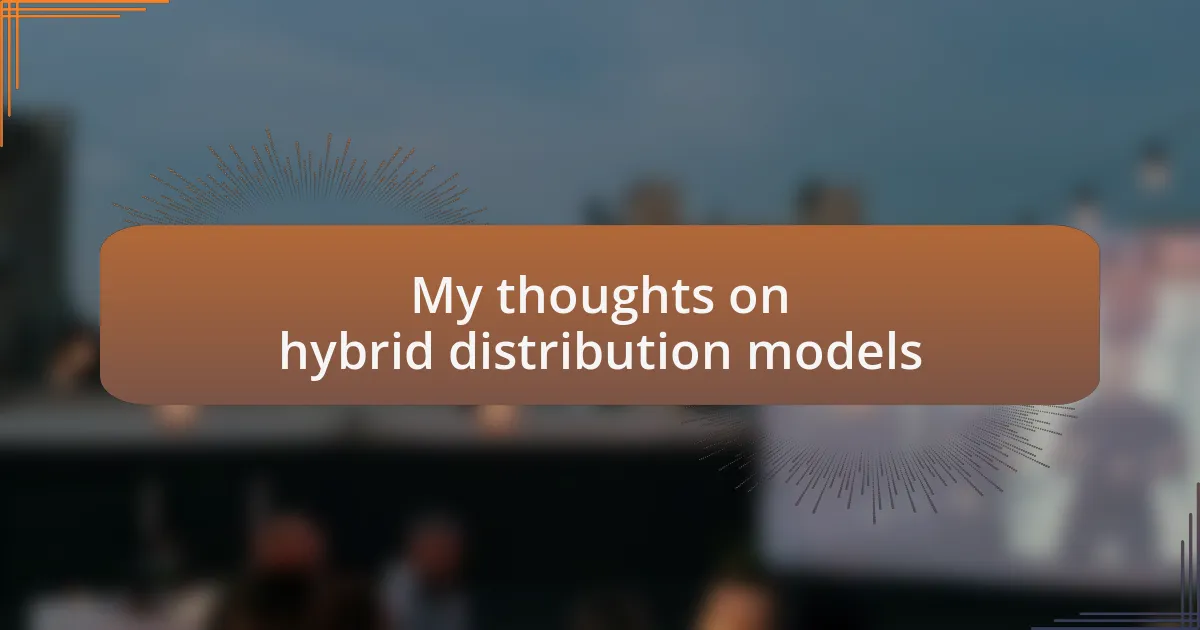Key takeaways:
- Hybrid distribution models combine traditional and digital methods, allowing filmmakers to reach diverse audiences and enrich viewer engagement.
- Effective distribution is crucial for independent films, impacting visibility and audience connection, often determining a film’s success or obscurity.
- The landscape of independent film distribution has evolved, enabling global accessibility and immediate audience feedback through online platforms.
- Challenges in hybrid distribution include balancing theatrical and digital releases, managing audience expectations, and navigating distribution agreements.
Author: Evelyn Hartwood
Bio: Evelyn Hartwood is a captivating storyteller and novelist known for her richly woven narratives and complex characters. With a passion for exploring the intertwining of human emotions and the natural world, her works often blend elements of magical realism with contemporary themes. A graduate of the Iowa Writers’ Workshop, Evelyn has published several acclaimed novels and short stories in prestigious literary magazines. When she’s not writing, she enjoys hiking in the mountains of her Pacific Northwest home and nurturing her garden. Evelyn continues to inspire readers with her unique voice and profound insights into the human experience.
Understanding hybrid distribution models
Hybrid distribution models blend traditional and digital methods to deliver content to audiences. I remember when I first encountered this concept while working on a small indie project; I was amazed at how combining theatrical releases with streaming platforms can create a more dynamic approach. Have you ever thought about how the flexibility of this model can open new doors for filmmakers?
By utilizing both physical and digital distribution, filmmakers can tap into different audience segments. It’s fascinating to think about how my own film garnered attention through festival screenings and later reached viewers through platforms like Vimeo and Amazon Prime. Doesn’t it feel empowering to know that we can reach audiences directly while still maintaining a level of traditional exposure?
Moreover, hybrid models often encourage a community-driven approach, fostering engagement beyond just viewing the film. When I shared my project on social media, the discussions that emerged added layers to the movie’s meaning, enriching the viewing experience. Isn’t it incredible how distribution can transform into a conversation, deepening our connection to the stories we tell?
Importance of distribution in film
Effective distribution is the lifeblood of independent film, shaping how and when audiences engage with a creator’s work. I once watched an indie film that struggled at festivals, yet a targeted online release turned it into a sleeper hit. Isn’t it amazing how the right distribution strategy can redefine a film’s trajectory?
Every filmmaker knows that even the best stories can fall flat without the right distribution. I remember the anxiety I felt when my first feature was about to hit the shelves; I realized that securing the right partnerships could mean the difference between obscurity and recognition. Have you considered how the visibility that comes from a solid distribution plan can elevate not just the film but the entire artistic journey behind it?
Distribution doesn’t just transport a film to audiences; it creates a sense of ownership and community among viewers. I cherish the conversations sparked by my film’s release; once, an audience member shared how a specific scene resonated with their own life experiences. This connection illustrates how distribution becomes a bridge, bringing people together through shared narratives. Isn’t it powerful to think our work can foster such meaningful relationships?
Overview of independent film distribution
Independent film distribution has evolved significantly, driven by the rise of digital platforms and shifting audience preferences. I recall my experience attending a small film festival where several indie filmmakers expressed their frustrations about traditional distribution methods. It was clear to me that understanding the intricacies of this landscape could make or break a project. Have you ever wondered how more accessible distribution channels have transformed the way we experience films?
Today, independent films can reach global audiences without the constraints of traditional theater releases. I once collaborated on a project that premiered online; the immediate feedback from viewers was exhilarating. This direct line to the audience created a unique connection that isn’t often felt when films simply hit theaters. Don’t you think this immediacy changes the filmmakers’ relationship with their audience?
Moreover, the hybrid distribution model is becoming increasingly popular. I’ve seen filmmakers successfully blend theatrical shows with digital releases, thus maximizing their reach while catering to diverse audience habits. It’s intriguing to think about how this flexibility allows filmmakers to engage their audience on multiple fronts, generating conversations that resonate across different platforms. Isn’t it remarkable how these evolving strategies can enrich the storytelling experience?
Challenges in hybrid distribution
One of the significant challenges in hybrid distribution that I’ve observed is the balancing act between theatrical and digital releases. In one of my earlier projects, we faced the dilemma of allocating resources to a physical premiere versus an online launch. The urgency to cater to both audiences often leads to compromises in marketing and can dilute the film’s impact. How do filmmakers decide where to invest their limited budgets to optimize reach?
Another hurdle is managing audience expectations. I remember a time when our film garnered buzz through social media, yet the turnout for our theatrical screening didn’t meet expectations. The excitement online didn’t directly translate to ticket sales in the theater, leaving us wondering if we had misjudged our audience engagement strategies. It’s crucial for filmmakers to understand that each platform may attract a different audience, and failure to recognize this can lead to disappointing results.
Lastly, there’s the issue of navigating various distribution agreements. I’ve encountered situations where filmmakers sign contracts that limit their future distribution options. One director I know was left frustrated when a streaming service’s exclusive agreement hindered their ability to showcase their film elsewhere. Isn’t it vital for independent filmmakers to seek legal counsel to better understand these agreements, ensuring their creative work remains accessible on their terms?
